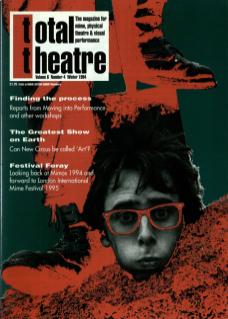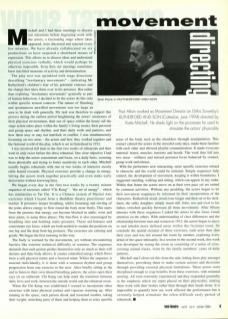Mitchell and I had three meetings to discuss our intentions before beginning work with the actors, a fascinating stage where ideas appeared, were discussed and rejected every few minutes. We have already collaborated on six productions so have acquired a shorthand means of expression. This allows us to discuss ideas and understand physical exercises verbally, which would perhaps be otherwise impossible. Even then our meetings sometimes burst into brief moments of activity and demonstration.
The play text was sprinkled with stage directions describing ‘involuntary movements’ – indicating Mr Rutherford's children's fear of his potential violence and the change that takes them over in his presence. But rather than exploring ‘involuntary movements’ generally as part of human behaviour, I decided to let the actors do this only within specific textual contexts. The nature of flinching and spontaneous unwilled movements was too large an area to be dealt with generally. My task was therefore to support this process during the earliest period, heightening the actors' awareness of their physical environment, their use of space within the house (all the stage action takes place within the family's living room), their personal and group space and rhythm, and their daily work and patterns, and how these may or may not interlock or conflict. I was simultaneously focusing on two areas: the actors and how they worked together and the fictional world of the play, which is set in Gateshead in 1912.
I was involved full-time in the first two weeks of rehearsals and then went in only twice before the dress rehearsal. One clear objective I had was to help the actors concentrate and focus, on a daily basis, warming them physically and trying to foster sensitivity to each other. Mitchell usually begins rehearsals with one or two weeks of intensive, mostly table-bound research. Physical exercises provide a change in energy, letting the actors work together practically and even make early discoveries without knowing lines.
We began every day in the first two weeks by a twenty-minute sequence of exercises called ‘Chi Kung’, ‘the art of energy’ – which has similarities to Tai Chi. It is a Chinese system of Martial Arts exercises which I learnt from a Buddhist theatre practitioner and teacher. It promotes deeper breathing, whilst loosening and circling of the joints allows energy to flow round the body more freely. This starts from the premise that energy can become blocked in ankle, wrist and knee joints, to name three places. The free-flow is also encouraged by breathing into and holding static postures. These aid balance and concentrate eye focus, which are both needed to sustain the positions on one leg and the deep bent-leg postures. The exercises are calming and gentle. We began the first morning in this way.
The body is warmed by the movements, yet without encountering barriers like extreme technical difficulty or stamina. The sequence demands that each person pushes themselves only as much as their will dictates and their body allows. It creates controlled energy which flows from a still physical centre and a focused mind. Whilst the sequence is enacted individually, it is done with a common rhythm and group progression from one exercise to the next. After briefly sitting at the end to listen to their own altered breathing pattern, the actors open their eyes on an outbreath. Chi Kung can help mark the transition between daily lives and work, between the outside world and the rehearsal room.
When the Chi Kung was established I wanted to incorporate other exercises with more physical contact and vigorous warming up. After running in the space, each person shook and loosened another, taking their weight, stretching parts of them and helping them to relax specific areas of the body such as the shoulders through manipulation. This contact calmed the actors in the stressful early days, made them familiar with each other, and allowed playful communication. It made everyone material: bones, muscles, tensions and breath. The work thus fell into two areas – stillness and inward personal focus balanced by contact, group work and release.
With the performers now interacting, more specific exercises related to character and the world could be initiated. Simple sequences help control; the development of movement, keeping it within boundaries. I suggested standing, walking and sitting, which can appear in any order. Within that frame the actors move on at their own pace yet are united by common activities. Without any prodding, the actors began to let their movement sequences be informed by their interpretation of the characters, Rutherford stood, stood even longer, and then sat at his desk. Janet, the sulky daughter, simply stood still. John, son and rival to his father, switched quickly between all three movements. After fifteen minutes with these sequences I asked the actors to also focus visual attention on the others. With understanding of class differences and the relationship between men and women in 1912, the actors began to move in and inhabit more defined areas within the fictional room. To conclude the spatial element of these exercises, each actor then shut their eyes and was led around the room by another, exploring every detail of the space intimately. In a session in the second week, this work was developed by seeing the room as consisting of a series of criss-crossing animal tracks, worn by the family members' years of daily patterns.
Mitchell and I observed this from the side, letting them play amongst themselves, provoking them to make certain actions and decisions through providing external physical limitations. These actors were disciplined enough to reap benefits from these exercises, with minimal steering. All were extremely experienced and they responded gratefully to the emphasis which my input placed on their physicality, making them work with their bodies rather than through their heads alone. It is impossible to quantify how my work affected the performance but it certainly helped stimulate the often difficult early period of rehearsals.

